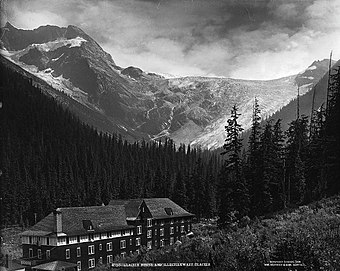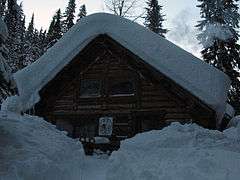Glacier, British Columbia
Glacier, which once comprised small communities, is on the western approach to Rogers Pass in southeastern British Columbia. The name derives from the Great Glacier, which in the 1880s was just over a mile from the original train station.[1]
.jpg)

Initial settlement
Glacier House
To avoid hauling additional weight up the significant gradient, Canadian Pacific Railway (CP) parked a dining car at this location for a passenger train meal stop. Already ruled out were the summit, with its avalanche paths,[2] and the steep river gorges of the eastern slope, which provided little space to develop facilities. This alpine meadow was an ideal setting for the Selkirk dining station.[1] In 1885, Thomas Charles Sorby, future architect of the first CP Hotel Vancouver, designed a chalet for this site.[3] The large dining room opened in November or December 1886, allowing the dining car to return to regular service.[4]
The 15-bedroom accommodation was ready for guests in January 1887, but staff occupied half these rooms. A sleeping car was soon parked permanently to accommodate overflows. A small two-storey station served the stop.[5] Bruce Price's 1889 design for a 22-room addition, was revised as the 32-room annex that opened in 1892.[6] Around 1898, the dining room was enlarged, and CP constructed a two-storey building with five bedrooms upstairs and a billiard room downstairs.[7] The 54-room wing, with elevator, and new reception area, opened in 1904. About this time, the station name changed to Glacier.[8] Few guests stayed through the winter.[9] Francis Rattenbury designed a substantial hotel on the site, but construction never proceeded beyond the footings.[10]
The initial manager struggled to handle the limited time allotted for the dining stop. Acknowledging the whole facility required professional management, CP signed a lease agreement with Harry A. Perley in 1887 to run the enterprise, which appears to have been operating at a loss. Perley received all revenue, without contributing to the cost of capital improvements.[11] After alleging for years that Perley's other hotel interests had prevented sufficient attention being paid to the Glacier operation, Mr. Sheffield, CP manager of hotels, succeeded in Perley's ousting.[12]
%2C_RP-F-F16125-B.jpg)
Miss A.E. Mollison, formerly at the CP Mount Stephen House, Field, was manager March 1897–December 1899. Succeeding her from Field was Miss Julia Mary Young, who stayed until 1920. Few details survive of the final managers.[13]
Albert W. Sharp was the inaugural postmaster, serving only four months in 1899.[14]
The observation tower was likely built in 1890, but a telescope was not added until 1898 to view mountaineers climbing the glacier and peaks. The tower was demolished around 1910.[15] Other structures included a baggage room, ice house, laundry houses, bowling alley, employee and guide quarters, stables, and powerhouse.[16] Electric lighting came around the turn of the century.[17] Manager Young converted the bowling alley into a curio store. A Union Bank branch existed from 1912, primarily for the tunnel construction workers.[18]
After 1909, when dining car use extended to the mountains, the Glacier House catering staff worked only the summers.[19] George Vaux Sr., with children Mary, George Jr. and William Jr. first came in 1887, and regularly revisited. The children became noted for their photography and documentation of the area and glacier.[20] It is unclear whether a doctor permanently staffed the small hospital.[21] Peter Sarbach, who came in 1897, was the first professional mountain guide. Proximity to the glacier resulted in the house having more Swiss guides than other mountain hotels. CP maintained hiking trails south of the railway track until 1926, while the Department of the Interior maintained those to the north.[22] Tourists would also visit the Nakimu Caves.[23]
Closed to the public in the fall of 1925, and guides the following year,[24] the rationale is confusing. Like Lake Louise, the ascent from the new station was onerous for horse-drawn vehicles. However, Lake Louise resolved this challenge with a gasoline-powered tramway (1912-1930). Despite the track infrastructure being in place, CP chose not to replicate this solution at Glacier. The more popular Banff and Lake Louise destinations were the CP priorities, and destructive fires at those hotels, in 1924 and 1926 respectively, drained investment capital. However, CP prepared grandiose plans for Glacier as late as 1926,[25] indicating construction within years. After CP laid off the caretakers in 1927, the buildings were looted and vandalized. The company demolished the remainder in 1929.[26] Rebuilding proposals faded with the Great Depression.[27]
Interpretive plaques beside the walking trail around the site identify the buildings associated with the remaining footings.

Stone arch bridge
The wooden railway trestle crossing the Glacier (Illecillewaet) Creek, 180 metres (590 ft) northeast of Glacier House, was replaced in 1900 with a stone arch bridge. Since that time, the current has severely eroded the southwestern riverbank, undermining the masonry. Repairs have been undertaken in recent decades.[28] In 2019, 470 tonnes of rock were placed to reinforce the concrete footings.[29] The Arthur O. Wheeler hut, a National Historic Site,[30] is 160 metres (520 ft) north of the stone bridge.
Loop Brook

Loops
Rogers Pass outlines the history of the Loops. The switchback loop configuration, comprising bridging, embankments, and following the hillside, ensued because the preferred alternatives did not fit the terrain.[33] The Loop Brook trail includes the stone pillars for the crossings south of today's highway.[34] Formerly called Five Mile Creek,[35] the crossing was known as Five Mile Creek Bridge.[36] Water erosion undermining the footing has toppled one of the pillars on the upper crossing.[37] Remnants from the former crossings north of today's highway are inaccessible.
West portal
Community & construction
Initially called the village of West Portal, during tunnel construction, about 300 workers were based here.[39] The highest point of the Selkirks track is just inside the tunnel mouth. During the 1919–1925 lining operations, the workforce peaked at 500. About 50 children attended the school.[40]
After the tunnel route became operational, the Rogers Pass and Glacier House communities gravitated to the west portal locality in 1917. However, CP maintained the road up to Glacier House.[15] A new log station was built, and the post office venue changed.[41] This coincided with the Morris family move from Rogers Pass, and the reestablishment of their store with Mrs. Ada E. Morris[42] as postmaster.[43] C.D. Morris[44] was a JP and secretary of the school board.[45] The largely Japanese section crew moved down from the pass, and with the watchmen, fan house employees, and telegraph operators, comprised the main population. Glacier had either a turntable or wye at different times.[46]
Following the completion of tunnel lining, the base population was about 100,[47] reducing to 50 by 1934.[48] Numbers reached 62 by 1941,[49] 66 by 1943,[50] and 93 by 1948. The school still existed at this time. It is unclear whether the establishment of an inn replaced or absorbed the general store.[51] Neither these, nor the school, existed a decade later.[52] Students boarded at Albert Canyon to attend elementary school, or at Revelstoke to attend high school.[46] The post office closed in 1960.[14]
During the Rogers Pass highway construction, 1956–1962, the headquarters camp was at Glacier.[52]
The passenger stop appears to have closed in the mid-1960s.[53] Although listed in later timetables, assumedly as a reference point, it is not marked even as a flag stop. However, in the pre-Via Rail era, it may have continued in use for pre-arranged stops. The log station, a National Historic Site,[54] appears derelict.
Although diesel generators had formerly provided electricity for residents, a BC Hydro connection came in the mid 1980s, when a line was extended from the Mount Macdonald Tunnel site.[46] Nowadays, CP maintains a small base for the operation and maintenance of the tunnel and tracks.
Accidents
1918: A tunnel watchman, struck by a train at the station, lost both feet and died of his injuries.[55]
1919: About 2 miles (3 km) west of Glacier, a freight train fatally struck two section hands hauling a sleigh along the track.[56]
1937: When a hopper fell beneath a freight train near Glacier, the wheels amputated both legs and one arm.[57]
1974: A freight train fatally struck two section hands working on the track 2.1 kilometres (1.3 mi) west of Glacier station.[58][59]
Footnotes
- Finch 1987, p. 65.
- Finch 1987, p. 64.
- Finch 1987, pp. 66–67.
- Finch 1987, pp. 67, 69.
- Finch 1987, pp. 68–70.
- Finch 1987, p. 74.
- Finch 1987, pp. 76–77.
- "1907 Timetable" (PDF). www.traingeek.ca. p. 11a.
- Finch 1987, p. 87.
- Finch 1987, pp. 78–79.
- Finch 1987, pp. 94–95.
- Finch 1987, pp. 99–102.
- Finch 1987, pp. 103–104.
- "Postmasters". www.bac-lac.gc.ca.
- Finch 1987, p. 114.
- Finch 1987, p. 80.
- Finch 1987, p. 90.
- Finch 1987, p. 73.
- Finch 1987, pp. 110–111.
- "BC Local News, 4 Aug 2011". www.bclocal news.com.
- Finch 1987, pp. 111–112.
- Finch 1987, pp. 112–114.
- Finch 1987, p. 115.
- Finch 1987, p. 104.
- Finch 1987, p. 117.
- Finch 1987, p. 118.
- Finch 1987, p. 119.
- Finch 1987, p. 28.
- "Revelstoke Review, 11 Dec 2019". www.revelstokereview.com.
- "Canada's Historic Places, Arthur O. Wheeler hut". www.historicplaces.ca.
- "Selkirk Summit" (PDF). www.parkscanadahistory.com. 1990.
- Downs 1968, p. 42.
- Finch 1987, p. 121.
- "Loop Brook Trail". www.pc.gc.ca.
- Finch 1987, p. 29.
- "Five Mile Creek Bridge". www.sfu.ca.
- Finch 1987, p. 124.
- Downs 1968, p. 40.
- "Mail Herald, 15 Nov 1913". www.ubc.ca. p. 4.
- "The Daily Colonist, 10 Sep 1924". www.archive.org. p. 16.
- Finch 1987, p. 111.
- "Death Certificate (Ada Elizabeth MORRIS)". www.royalbcmuseum.bc.ca.
- "1918 BC Directory". www.bccd.vpl.ca.
- "Death Certificate (Curtis Dexter MORRIS)". www.royalbcmuseum.bc.ca.
- "1919 BC Directory". www.bccd.vpl.ca.
- Mason, Phil (2011). "A Tale of Glacier". www.okthepk.ca.
- "1927 BC Directory". www.bccd.vpl.ca.
- "1934 BC Directory". www.bccd.vpl.ca.
- "1941 BC Directory". www.bccd.vpl.ca.
- "1943 BC Directory". www.bccd.vpl.ca.
- "1948 BC Directory". www.bccd.vpl.ca.
- "Prince George Citizen, 17 Oct 1957". www.pgpl.ca. p. 11.
- "1962–63 Timetable". www.ubc.ca. p. 7.
- "Canada's Historic Places, Glacier CP railway station". www.historicplaces.ca.
- "The Daily Colonist, 25 May 1918". www.archive.org. p. 2.
- "Revelstoke Review, 24 Mar 2019". www.revelstokereview.com.
- "The Daily Colonist, 9 Apr 1937". www.archive.org. p. 6.
- "The Daily Colonist, 15 Nov 1974". www.archive.org. p. 19.
- "Death Certificate (Ceko CEKOV)". www.royalbcmuseum.bc.ca.
References
- Finch, David A.A. (1987). "A History of the Canadian Pacific Railway in Glacier National Park, B.C., 1884–1930" (PDF). www.parkscanadahistory.com. Environment Canada.CS1 maint: ref=harv (link)
- Downs, Art (1968). "Incredible Rogers Pass" (PDF). www.uvic.ca.CS1 maint: ref=harv (link)